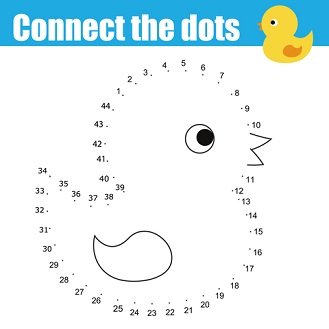What to do with this activity?
At the age of 3 or 4, children are still learning how to hold and control pencils or crayons to make marks on paper. They need lots of practice at scribbling, drawing and making marks to be able to form letters and numbers in the future. Encourage them to scribble on old newspapers or recycled paper.
As they grow more confident in their movements, have fun with projects that need more precision and care. For instance, try these connect the dots games from Daycare Worksheets, or these from Connect the Dots. You can download and print these, or get ideas and copy them as best you can. At this age, it's not about knowing the numbers. It's about trying to draw a short line from one dot to the next. The important thing is the attempt at getting it right, not how it turns out. Remember to praise your child for their effort.
-
Why am I doing this?
There are at least four stages in learning to write. The first is movement - your child learning to control their body and their hands - reaching, feeling and holding things - is part of this first stage.
The second stage is making marks - seeing that if you put this crayon here and move it, it makes a mark.
Drawing is a third stage.
The fourth then is learning how to make letters and later words.
For your child, the more they are aware about how useful writing is, the better. Seeing you writing is great and you pointing out other people writing will help them see how useful it is too.
-
How can I do more?
It’s always good to keep crayons and paper close at hand, so that you can give them to your child anytime to play with.
Write words under your child’s drawing – like their name or what they have drawn – that will help them understand the meaning of words.
Later you could clip 10 or 12 of these drawings together to make a book. This will show your child how books can be made.
Let your child see you writing – notes, lists, letters and emails. If you don't write much yourself, show your child other people writing when you are out and about.
Encourage your child to use ‘pretend’ writing in play - writing their own name, notices or price lists. You could even give them a little notebook when you go to the shops or when they’re playing ‘shop’ with their friends.
Rate this activity
![]()
![]()
![]()
![]()
![]()
Based on 1 review
How would you rate it?
1 = Poor, 5 = Great.



